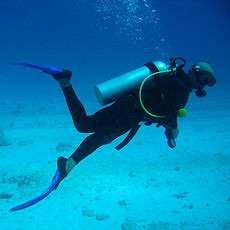Towboard
 A towboard being used by a NOAA archaeologist to search for shipwrecks in the Papahanaumokuakea Marine National Monument | |
| Uses | Towed diver search or survey |
|---|---|
| Related items | Diver propulsion vehicle |
A towboard is a piece of aquatic survey equipment consisting of a board attached to a rope that is towed by a surface vessel. It is used to tow one or more divers underwater at a constant depth to survey bottom features such as coral reefs. The diver may use a scuba set, or if only a snorkel, may remain at the surface, or travel underwater for around two minutes.[1]
The towing vessel travels at approximately 1 to 2 miles per hour and may tow two divers, one with a camera pointing down, and other with a camera facing forward. The boat follows a depth contour to keep the towboard over a specific depth. The divers can also maneuver the board to maintain a more precise depth and avoid obstacles. A survey may cover up to nearly 2 miles over a period of around 50 minutes.
This type of surveying method is called a towboard survey, towed-diver survey,[2] and the manta tow technique, the latter named after the Manta Board, an oval towboard marketed for recreational use.[3][4] A variant is the SAM or "Single-armed Manta-board". This consists of a small board with a strap to secure and tow the diver by the forearm. This frees the other arm, allowing the diver to take notes on a pad held by the towing arm.[5]
The use of a towboard is considered safe for NOAA reef surveys by trained divers at depths where no decompression stops are required (down to approximately 90 feet).[6]
Towboards may be equipped with sensors to record the temperature and depth every few seconds and the tow vessel may have a GPS to record position. Position of the diver is approximate and must be calculated from the boat position, heading and towline length.[6][7][8]
References
- ↑ http://www.aims.gov.au/334
- ↑ https://data.noaa.gov/dataset/cred-towed-diver-benthic-characterization-survey-at-niihau-main-hawaiian-islands-in-2010
- ↑ http://www.unesco.org/csi/pub/source/rs12b.htm
- ↑ http://www.aims.gov.au/334
- ↑ Zimmerman, Kenneth D.; Burton, Thomas E (1994). "A Single-armed Manta-board as a New Diver-controlled Planing Board and Its Use for Underwater Surveys" (PDF). Marine Fisheries Review. pp. 12 – 16. Retrieved 13 June 2016.
- 1 2 "NOAA PIFSC - Towboard Diver Surveys". noaa.gov.
- ↑ "NOAA's Coral Reef Conservation Program: What is a Towed Diver Survey?". noaa.gov.
- ↑ "NWHI: Video: Tow Boarding". hawaiianatolls.org.
External links
- Crown-of-thorns starfish and coral surveys using the manta tow and scuba search techniques, D.K. Bass and I.R. Miller
